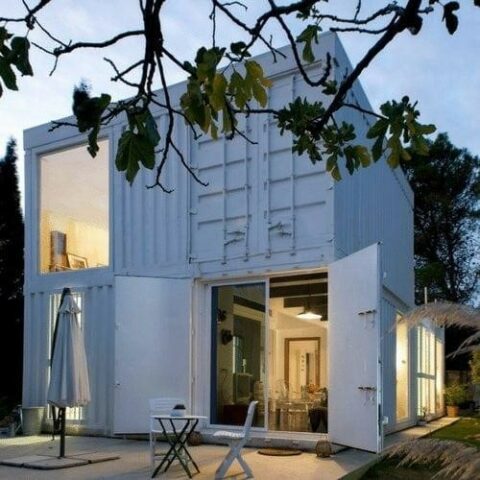
Shipping container homes are an increasingly popular option for those looking to construct their own homes. After all, they are eco-friendly, easy to customize, and cheaper than building a traditional home.
Heating a shipping container home, however, has both benefits and drawbacks. Container homes are by their very nature small, which makes them easier and less expensive to heat than the average house. But shipping containers are essentially steel boxes.
Heat moves through steel more easily than through traditional home materials, meaning that shipping container homes struggle to retain heat and can become extremely cold when the temperature drops.
Fortunately, there are many steps you can take, from choosing the right heating system and insulation to taking care of your windows and making small changes in your daily routine, that can keep your shipping container home warm during the longest winter.
Types of Heating Systems in Container Homes

When deciding on the right heating system for your shipping container home, there are many factors to weigh, from cost and ease of installation to energy efficiency and carbon footprint. However, the most important aspect to consider when heating a shipping container home is the climate where your container home is located. Heating systems that are adequate in milder climates won’t be sufficient in areas with harsher winters.
Wood Burner or Portable Heater
If your climate is extremely mild, you might be able to get away with only using a wood burner or a portable heater. Both are inexpensive to buy and operate and would be able to quickly heat a small area. However, neither are very energy efficient or capable of heating larger spaces well for an extended period of time. They are always great supplemental heat sources but could only serve as primary heating systems in temperate areas.
Window Air Conditioner Units with Heat Pumps
One step up from wood burners, and portable heaters would be window air conditioning units with heat pumps and electric wall heaters. Both are relatively inexpensive and easy to self-install.
While still not great at heating large spaces, they do much better than wood burners or portable heaters, and you can always combine multiple units to provide more heat. Overall, window units and wall heaters would work well if your home is in a moderate climate.
Baseboard Heating and Water Underfloor Heating
In those areas where winter temperatures become extreme, you will need a stronger heating system than any of the previous suggestions provide. Two possibilities that have become popular for storage container homes are baseboard heating and water underfloor heating.
With baseboard heating, cool air is drawn into the baseboard, heated by electricity, and then released into the room.
Water underfloor heating works similarly to a radiator, with hot water circulated through pipes, just beneath the floor. Therefore, it doesn’t take up any room in your living space.
Underfloor heating can be very energy efficient, while baseboard heating is less so, but can be effective if paired with supplemental heating systems.
Both are cheaper than most traditional heating systems, and both can be self-installed, but do require a higher level of skill.
Tips for Keeping your Container Home Warm
Insulation: The Key to Retaining Heat
In order for your shipping container home to maintain a comfortable temperature, your insulation is just as important as your heating system.
For container homes, the four main insulation options are spray foam, cotton, wool, and cork. The potential pros and cons of each type can be found in our ultimate guide to shipping container insulation.
Prevent Heat From Escaping Through Your Windows

Another factor that contributes to your shipping container home’s ability to retain heat is your windows, as they are the main way that warmth escapes your home. There are both high- and low-cost options to make your windows a better barrier against extreme temperatures.
Although more expensive than single-pane windows, double-paned windows have a much higher insulating value and majorly improve your home’s energy efficiency. In the long run, the savings in energy costs and increased comfort of your home may be worth the extra cost.
Additionally, small gaps around your windows and external doors created during the modification of your shipping container home allow warm air to leak outdoors.
Inspecting your windows and doors and sealing the gaps with silicone caulk bought from your local hardware store is a cheap solution that will greatly impact your home’s heat retention.
Invest in Rugs and Curtains
A few minor adjustments can make a huge difference in keeping your shipping container home at a comfortable temperature without increasing your energy bill.
For example, shipping containers typically come with wood floors, which feel quite cold during the winter (unless you decide to invest in an underfloor heating system).
Placing a rug on your wood floors can slow heat loss and make your home much cozier during the long winter months.
Another small step you can take is using your curtains to your advantage.
Opening the curtains during daylight hours allows you to benefit from the sun’s heat, and closing them at night prevents that heat from escaping. Investing in thicker curtains or winter curtains can be a relatively cheap way to add insulation to your home.
Finally, you can make your home feel much warmer through small changes to your use of your living space. Closing the doors to rooms, not in use will allow your heating system to work more efficiently in the room you are in and thus maintain a higher temperature. Rearranging your furniture for the winter so that you are not sitting near drafty windows or doors won’t actually change the temperature of your home, but will make the season much more comfortable for you.
Conclusion

Now that you’ve read our tricks and tips on heating a shipping container home, it’s time to start planning a shipping container home of your very own! If you would like more helpful advice like this, check out the rest of ContainerHomeHub.com.
There, you will find all kinds of resources, like our shipping container home FAQs. You will also find featured container homes and companies that build container homes. These will help you get inspired and start the process of making your dream shipping container home a reality.

